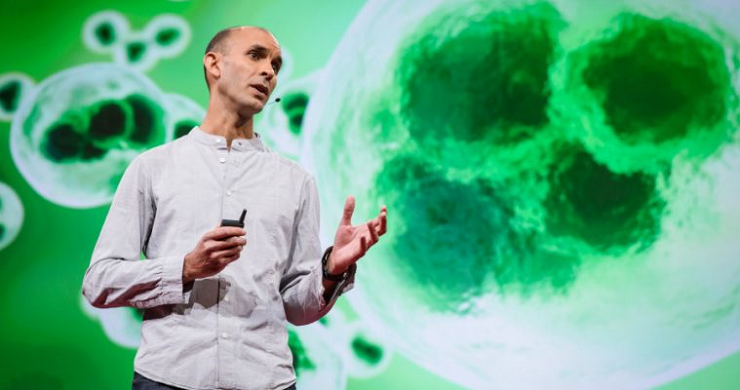The Controlled Hallucination | How Our Brains Construct Reality | Unraveling the Intersection of Neuroscience, Consciousness, and the Illusion of Existence
 Our perception of reality is not a direct imprint of the external world but a vivid construction orchestrated by our brains. As neuroscientist Anil Seth revealed during his TED Talk, our brain generates conscious experience through a fascinating interplay of electrical signals and predictive coding—a process so compelling that it can even mimic the effects of a near-death experience. This idea that our sensory reality is essentially a “controlled hallucination” challenges the conventional notion of perception, urging us to explore the inner workings of our consciousness with fresh eyes.
Our perception of reality is not a direct imprint of the external world but a vivid construction orchestrated by our brains. As neuroscientist Anil Seth revealed during his TED Talk, our brain generates conscious experience through a fascinating interplay of electrical signals and predictive coding—a process so compelling that it can even mimic the effects of a near-death experience. This idea that our sensory reality is essentially a “controlled hallucination” challenges the conventional notion of perception, urging us to explore the inner workings of our consciousness with fresh eyes.
Central to this concept is the idea that the brain functions as a prediction engine. Instead of passively receiving sensory input, our brain actively interprets and constructs experiences by merging incoming signals with prior expectations. For example, the perception of a simple color such as yellow emerges not merely from wavelengths of light but from the brain’s elaborate guesswork. Much like the optical illusions that play tricks on our vision, these neural predictions often yield a reality that, while consistent with our expectations, is far removed from an objective external truth.
Delving deeper into the mechanics of perception, experiments such as the rubber hand illusion vividly illustrate how our sense of body ownership can be manipulated. When a fake hand is stroked simultaneously with a hidden real hand, the brain seamlessly integrates the illusion into our body schema. This phenomenon, highlighted in Seth’s talk, demonstrates that even the experience of having a physical body is a construct—one that is continuously updated through multisensory integration. In essence, both the external world and our internal bodily sensations are products of the same predictive processes.
From an evolutionary standpoint, this remarkable ability to construct reality has clear survival advantages. The brain’s capacity to quickly generate a coherent model of the world allows us to respond to threats and opportunities with astonishing speed. Over millions of years, this predictive mechanism has evolved to prioritize survival over absolute truth, suggesting that the reality we experience is a finely tuned balance between sensory inputs and ancestral expectations. This perspective not only aligns with the principles of Darwinian evolution but also challenges us to reconsider the nature of consciousness itself.
The interplay between sensory data and predictive coding is not only pivotal for basic perception but also for the formation of our personal identity. Seth’s insights remind us that our sense of self is another kind of controlled hallucination—an ever-adapting narrative generated by the brain. Through the fusion of memories, social interactions, and internal bodily signals, our brains construct a continuous and coherent self-image, even though it is as much a product of prediction as it is of perception. This nuanced understanding bridges the gap between neuroscience and philosophy, compelling us to question what it truly means to be “conscious.”
The implications of viewing consciousness as a controlled hallucination extend far beyond academic curiosity. In mental health, for instance, this model opens new avenues for understanding and treating conditions such as depression and schizophrenia, where perceptual predictions may go awry. By identifying and correcting these misalignments, clinicians can better address the root causes of such disorders rather than merely alleviating their symptoms. This paradigm shift not only enhances our grasp of human cognition but also fosters innovative approaches to healing.
In summary, the synthesis of insights from Anil Seth’s research and the broader field of neuroscience presents a compelling case: our entire conscious experience—every sight, sound, and feeling—is a dynamic construct of our brain. This controlled hallucination, refined over evolutionary time, provides us with a functional, albeit subjective, reality that enables survival in a complex world. As we continue to unravel the mysteries of perception and self, we are invited to embrace a deeper understanding of our existence—one that celebrates the marvel of being alive while questioning the very nature of reality.
Key Takeaways:
- Controlled Perception: Our brain actively constructs our conscious experience through predictive coding, making perception a dynamic interplay between external signals and internal expectations.
- Constructed Self: The sense of self is not an inherent, immutable entity but a continually updated narrative created by the brain’s integration of sensory data and memories.
- Evolutionary Advantage: This predictive mechanism has evolved to prioritize survival, providing us with a coherent yet subjective reality that enables quick responses to our environment.
“We all hallucinate all the time, including right now.”
Dive deeper into the mysteries of consciousness and explore related topics on SpeciesUniverse.com. Join the conversation by sharing your thoughts, engaging with our community, and discovering how our brain’s hidden processes shape the reality we live in every day.
More details: here
~Comments always welcome…
Relevant Content:
References:
- Collective-Evolution.com (Website)
- TED (YouTube Channel)

Leave a Reply